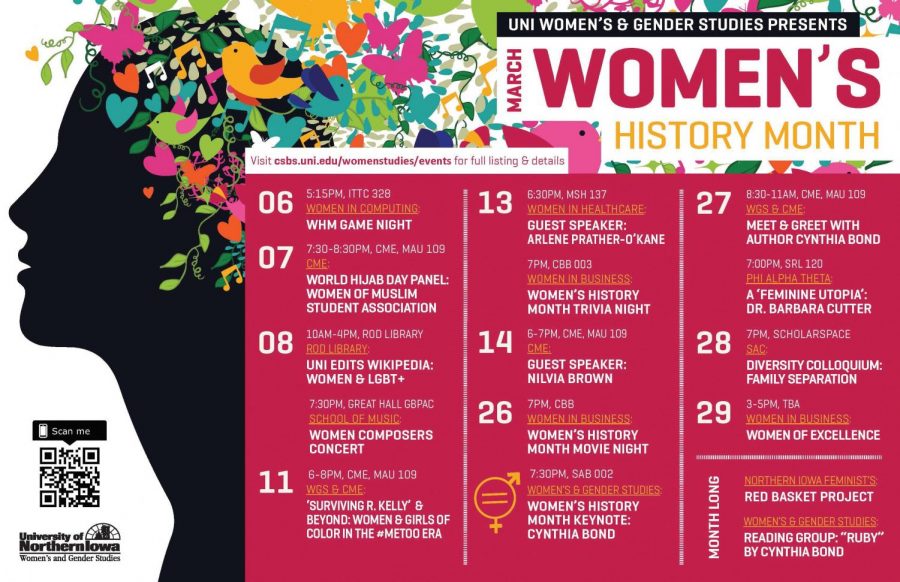Women’s History Month
Mar 11, 2019
Since the 1980s, the United States has recognized March as Women’s History Month. March 8 is celebrated around the world as International Women’s Day, but the United States reserves the entire month for recognizing that women have often been disregarded for their contributions to history.
“[Women’s History Month] reflects two related but distinct cultural shifts,” said Cara Burnidge, a professor of philosophy who is featured in Women Also Know History, an online database dedicated to female historians. “First, recognition that history classes and textbooks largely neglected or ignored women as full participants in our nation’s history. Second, an expansion of who produced knowledge about our country’s past — more women were able to become professors, writing new scholarship and textbooks. These changes helped to raise awareness of a multiplicity of ‘founders’ to American history and lift up out of obscurity the stories of women and people of color who made significant contributions to American life.”
When this celebration of women started under President Jimmy Carter in 1980, it was only a week long. Due to the petitioning efforts of the National Women’s History Project, the week was expanded to an entire month in 1987, according to History.com
In the years following the first Women’s History Month, Congress passed resolutions requesting the president to continue holding Women’s History Month. In 1988, Ronald Reagan issued the first presidential proclamation regarding Women’s History Month. Every president since Bill Clinton in 1995 has made an annual proclamation to designate March as Women’s History Month, according to WomensHistoryMonth.gov.
“For me, Women’s History Month is so important because for so long women were kind of an outlier, especially in learning about history,” said Sara Naughton, a programming graduate assistant for Women’s and Gender Studies. “Even today when you take a history course, there’s no such thing as ‘men’s history.’ History is just a history course unless you’re taking U.S. women’s history or European women’s history. So Women’s History Month is kind of a way to make women front and center.”
International Women’s Day has the same goal, Naughton said, except it takes a less ethnocentric perspective by celebrating women beyond the United States and across the globe.
“As we all know, women have actually suffered a long issue of inequality in terms of political and then social, economic standards and all that,” added Joyceline Amoako, who is also a programming graduate assistant for Women’s and Gender Studies. “A lot of women in the past really fought for this cause. Women’s History Month is more like celebrating how far women have come in terms of rights and then what others have done in the same course.”
Every year, Women’s History Month has a theme, which is published by the National Women’s History Alliance. This year’s theme is Visionary Women: Champion of Peace and Nonviolence. The theme is meant to recognize women who have helped to end wars, violence and other injustices and sought to change society through nonviolent means, according to aNationalWomen’sHistoryAlliance.org.
“I think around this time of year, there’s a lot of backlash about Black History Month and Women’s History Month,” Naughton said. “[People say,] ‘Where’s White History Month? Where’s Men’s History month?’ And I think people who feel that way — this is definitely a good time for them to reflect on why we might have months that recognize marginalized populations. If they have any questions, they’re welcome to contact Women’s and Gender Studies. I think that’s why the months are there. That’s why they’re designated for people to take time to reflect and celebrate.”
Despite all the progress women have made, Naughton was quick to acknowledge the change that still needs to take place.
“When we look at history, marginalized populations such as people of color and women have not been considered equal on most forefronts, if not all,” Naughton said. “We’ve come really far but to say that we’ve reached equality or equity is a little bit delusional.”
“Many people continue to think that women are ‘side’ characters rather than movers and shakers,” Burnidge added. “Many people question whether or not the changes made to history textbooks to include women were necessary or merely ‘politically correct.’ Additionally, there is plenty of research demonstrating the depth of gender biases within universities.”
The Women’s and Gender Studies Program has created a master calendar encompassing all campus events scheduled for Women’s History Month. It can be found at csbs.uni.edu/womenstudies/events.
On Monday, March 11 there will be a panel discussing the recent documentary series “Surviving R. Kelly.”
“[The panel] is to discuss how the #MeToo movement, in all of its ability to bring sexual assault to the forefront, has kind of ignored women of color and girls of color,” Naughton said.
On Tuesday, March 26, New York Times best-selling author Cynthia Bond, author of the novel “Ruby,” will be speaking in Sabin Hall. Bond will also hold a meet-and-greet in the Center for Multicultural Education on Wednesday, March 27.
Some of the other events include women-focused student organizations such as Women in Business and Women and Computing. These groups will be having their regular meetings with a special focus on recognizing Women’s History Month.






